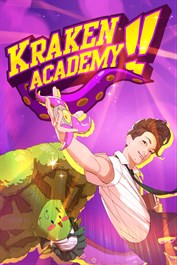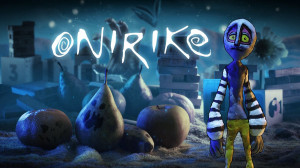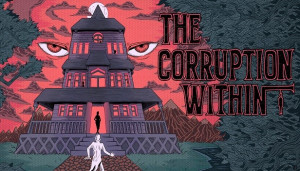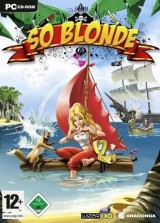Review for Kraken Academy!!

Game information
The concept of recurring days has become increasingly popular ever since the wonderful Groundhog Day. Happy Broccoli Games’ Kraken Academy!! sends its nondescript young male protagonist to a dilapidated boarding school, where he becomes trapped in just such a time loop until he can save it from certain doom. It’s a top-down adventure game that has you running errands, completing missions and meeting a strange collection of students and faculty, all while the academy itself crumbles around you over and over again. With its colourful cast, delightful score, and solid visual novel elements, the game’s potential is clearly on display, but its graphics are a mixed bag and its emotional impact is undermined with each recurring cycle and undeserved climaxes to individual stories.
The game begins with a road trip to the academy as you are about to start your first day. Curiously, you arrive at the school to find that it is completely run-down, with broken cars littering the area and grimy vending machines lining the walls. Graffiti is everywhere, and every building or structure is falling apart. Whatever is afflicting the property is affecting the people as well, as you see a hobo being chased and attacked by a student before you even get to your first class. There is a picture being painted here, of uncontrolled decay and depravity. And then things really get weird. As you’re witnessing the hobo abuse, a girl – or rather, a feminine anthropomorphic piece of broccoli – gets you to follow her to your first class.
Broccoli Girl is only the first example of a very interesting cast; the greatest strength of Kraken Academy!! is in the variety and quality of its characters. Each student or member of faculty has a distinctive trait: Dimitri is obsessed with fighting bears, Vladimir is indescribably handsome and runs his own fan club, while the art teacher Mr Whistler seems to be modelled after Bob Ross in both appearance and personality. Besides Broccoli Girl, almost all of them are human, the other exceptions being an artistic dog named Patitsa, and of course the titular Kraken itself. There is an in-game form of social media called “Kraken-Net” that you can easily access any time and is updated whenever you meet a new person, showing you their likes and dislikes along with a short bio. The one weakness here is the protagonist, who is a very simple-looking guy without any particular physical or personality quirks. He’s a completely blank slate (you even get to name him yourself), which may have been the developer’s intention but it just made me care less about him.
It’s during your first class that you’re introduced to the mini-games. Certain tasks will involve tests of your reaction speed and ability to mash a button quickly. There are only two types, and these sequences generally just alternate between the two. There is an option at the beginning of the game to choose between easy and normal difficulty, though even on normal I found these mini-games of absolutely no challenge whatsoever. If anything, they simply halt the pace of the game for no real reason other than to cram some short-lived variety into the gameplay. You can usually expect one of them to occur in most missions. The one saving grace is that the consequences based on how well you do can be quite amusing. For example, if the mini-game is initiated by a teacher asking you a question, the resulting wrong answer given by the protagonist can be quite funny.
Before long you’ll be sent to the nearby lake to find a Halloween costume (Broccoli Girl says people dump their stuff there all the time). There you are greeted by a giant Kraken, the legendary creature with its massive tentacles and a green jewel embedded in its forehead. The beast cuts straight to the chase: the school is going to be destroyed in three days, set in motion by a traitor in your midst. You are tasked with stopping this from happening, and to help you accomplish this mission is an amulet that can take you back to the beginning of this three-day period as often as you like. You accept this responsibility without question, which begs the question: why? The place is a dump and you haven’t been here long enough to make any friends. There is absolutely no motive for undertaking this mission, except for the fact that a talking octopus asked you to do it. This disconnect is one of the game’s many loose attempts to form a cohesive plot, resulting in a series of bizarre yet disjointed scenarios.
Beginning with Broccoli Girl, the overall objective is to free the four spirits that used to reside in the academy but are now trapped inside the bodies of troubled students, unbeknownst to the hosts. Each of these students happens to belong to one of the four different clubs: music, drama, sports, and art. Only by dealing with their personal woes can you remove the spirits inside them, which means getting to know the troubled students before undertaking a mission to help you figure out how to finally free their spirits. This usually involves spending a bit of time in their classes, exploring their club areas, listening to conversations, and doing activities that initiate more mini-games. These missions are completely linear, though a couple of them mix up the gameplay a little bit. One involves a not-so-subtle nod to the Ace Attorney series, involving a trial where you are required to present evidence that contradicts statements made by witnesses. It’s a fun diversion at first, but it goes on for quite a while and ultimately pales in comparison to its inspiration. Another mission has you infiltrating a secret base, with some simple puzzles involving floor buttons and secret codes.
Sometimes a possessed student is so troubled that they’ll do horrendous things to others. Rather unbelievably, I noticed a trend in most mission climaxes where feuding or wronged characters would suddenly change their minds and forgive recent transgressions simply in the name of friendship, a payoff that felt weak, unearned, and nothing to do with your actions. Narratively the reward is short-lived anyway, since the time loop always resets and everyone will forget that any of it ever happened. Thankfully freed spirits stay free, so you don’t have to worry about releasing them all in the same loop, which would be impossible anyway since each mission usually takes place right at the end of each three-day cycle.
The academy is populated with students to talk to, some unique and others generic. You’ll spend most of your time running from place to place as you look for items and perform tasks. The action is viewed from a bird’s-eye perspective as you run around with the WASD keys, using Shift to sprint (though I found running quite unwieldy and ended up bumping into everything). Gamepads are fully supported, though I found myself walking into things a lot more often so I stuck with the keyboard. The Tab key opens menus that allow you to view your inventory, quests, Kraken-Net, and the map. The map simply shows you which area you are in, with small images to represent each one. There is no quick travel option, but the sprinting speed is quite quick and I never felt impatient while roaming around.
You can also pick up side quests if you wish. These will almost always have you find some item and give it to a particular person, requiring zero brain power to complete. They do provide a little bit of flavour in revealing more about the cast and what life is like in the academy though. One character needs you to find ingredients so he can make a birthday cake for his friend, while another wants stamps so he can reply to his fan mail. Quests can develop into longer stories that culminate in a date or outing with the character in question, and usually on completion you’ll be given a “friendship badge.” If you attain enough of these, it will unlock the ability to purchase plastic bottle converter upgrades, which increase the amount of gold you get for each bottle you return.
At the beginning of the game you are given a baseball bat with which you can smash bins, dumpsters and leaf piles to pick up plastic bottles. These can be exchanged for coins at bottlecap machines, which can then be used to buy dorm decorations at the small market area just outside the academy entrance, as well as more bottle conversion upgrades from the aforementioned hobo in his cave. These are entirely optional, however; the only mandatory wares are those of the shifty faculty member Stix, who exploits students by forcing them to pay for access to their clubs.
Presented in a simple pixel art style, the insides of buildings can be disappointingly bare in terms of detail, but the outdoor scenes are peppered with graffiti, trees, fountains, and other things you might find on school grounds, albeit decaying ones in this case. The colour schemes used in and around the academy are also quite unappealing muddy greens and browns, and they clash with the vibrant art direction of the menus and dialogue sections. Conversations are easily the best part of the game visually. They’re displayed in the style of a visual novel, with dialogue appearing in a text box at the bottom of the screen with a wave-like animation and a very satisfying tip-tapping sound. Hand-drawn portraits are overlaid on either side of the screen when someone is speaking. The character art is pleasing to look at and tells you almost everything you need to know about the person even before they say anything, and there are different illustrations to convey changing moods and emotions. There is no actual voice acting, but audible sighs, moans, groans, and other exclamations accompany most sentences.
The quality of dialogue is equally excellent for the most part, and is usually quite funny. From the first line each character speaks, you can tell what they’re all about. Vladimir has the self-absorbed audacity to ask you if you want to join his fan club as soon as you meet him, whereas Broccoli Girl is panicked and enthusiastic about making it to your first class on time. There are occasional response options during conversation, where you can choose to be grumpy or happy, sassy or docile, and other choices along these lines. These don’t really affect anything, however, and end up feeling redundant.
The music for Kraken Academy!! deserves its own special mention. Svyatoslav Petrov’s midi-style score perfectly encapsulates the atmosphere of each and every moment it accompanies. It is full of character and cleverly composed, nostalgically reminding me of the Game Boy Advance era, as if I were listening to one of the great and classic soundtracks of that time. It serves as a jaunty backdrop when traipsing around the academy, and the subdued brass and woodwind-type simulated instruments add just the right air of mystery when necessary.
The time loop consists of three full days, each split into segments. If you want to skip forward in time, you can either sleep in your dorm or call your mom at one of the many phone booths scattered around. The clock ticks in real time (represented by a progress bar at the top of the screen) as you meander around the academy, whilst conversations freeze it, as do missions. Days are split into morning, afternoon, and night, and you never really feel like you’re in a rush to get from A to B. Some cutscenes and events will leap time forward an appropriate amount; for instance, participating in a class will take you through the afternoon. There is no way to be sure of a specific student’s location at any given time, unfortunately, so you’ll have to wander around and hope to stumble across them. Even then you’ll likely forget where and when you saw them if you don’t make a note. There are some reasonably safe bets to try, such as dormitories or club areas, but these are never guaranteed. Some sort of journal that keeps track of where students can be found at a particular point in time would have been very welcome.
It's also a shame there is no system in place to save you from having to repeat certain conversations or activities. As a result, it’s best to focus on a single quest line at a time, or else face the risk of having two things to do in one time block with only enough time for one and having to abandon one of the quests, setting you back to square one when the next time loop comes around. Thankfully you can click through dialogues to speed through them, but even that is a pace-halting chore when you just want to get on with things. If you don’t finish a quest by the end of a loop, you’ll likely have to go through the whole quest again, unless it’s a simpler fetch quest, in which case you can simply give them the item whether they asked for it during the current cycle or not, leaving them dumbfounded at how you knew exactly what they needed before they even told you.
Ultimately the time-loop aspect feels somewhat tacked on. There aren’t any puzzles that make use of it, and removing it completely wouldn’t change anything of importance about the experience. Sure, different people can be found in different places at different times, but there’s no way to track it and they’re not usually doing anything interesting, just standing around waiting for you to activate the quest they have for you at that specific point in time. Not to mention that the academy setting and the recurring days theme are ill-suited to each other. Usually in a game that takes place entirely in a school, you'd expect to build relationships with a cast of fellow classmates. Kraken Academy!! allows you to socialise to a certain extent with the friendship badges, though it becomes utterly impossible to do so in a meaningful way, since you’re new and they all forget who you are as soon as a new loop begins.
The latter part of the game involves some boss fights where, out of the blue, you are suddenly expected to run around and dodge attacks, then strike the enemy with your baseball bat when the opportunity arises. This is particularly jarring since the first 90% of the gameplay doesn’t involve any action whatsoever. Luckily for people that might struggle with or dislike this sort of gameplay, there is an option to turn on an invincible mode so you can’t fail.
If you come into Kraken Academy!! expecting an interesting time-loop adventure or meaningful social interaction in a school setting, you will find only lacklustre attempts at both. What it does have to offer is a colourful cast of characters, most of whom have at least one notable idiosyncrasy that makes them worth spending time with, along with some stylish visual novel elements, and music that elicits a great sense of fantasy and wonder – admittedly more than the story is able to provide. Any sort of puzzle difficulty is non-existent, but a variety of gameplay types can keep things fresh, even if they largely feel shoehorned in between fetch quests. There’s passion evident throughout, but what could have been a delightful romp ends up with decidedly mixed grades for how it all comes together.
WHERE CAN I DOWNLOAD Kraken Academy!!
Kraken Academy!! is available at:
We get a small commission from any game you buy through these links (except Steam).Our Verdict:
Kraken Academy!!’s strengths are largely skin deep, let down by the lack of focus and care put into its gameplay and story. Amusing, quirky characters may keep you going for a while, but this isn’t a game you really want to be stuck in as time loops repeatedly.




























